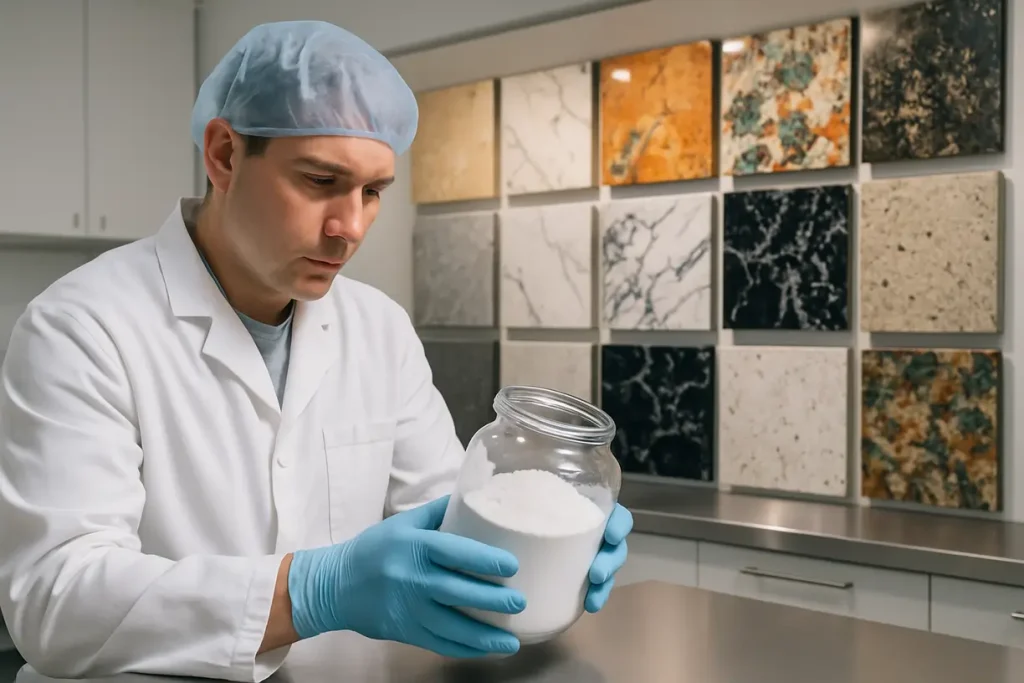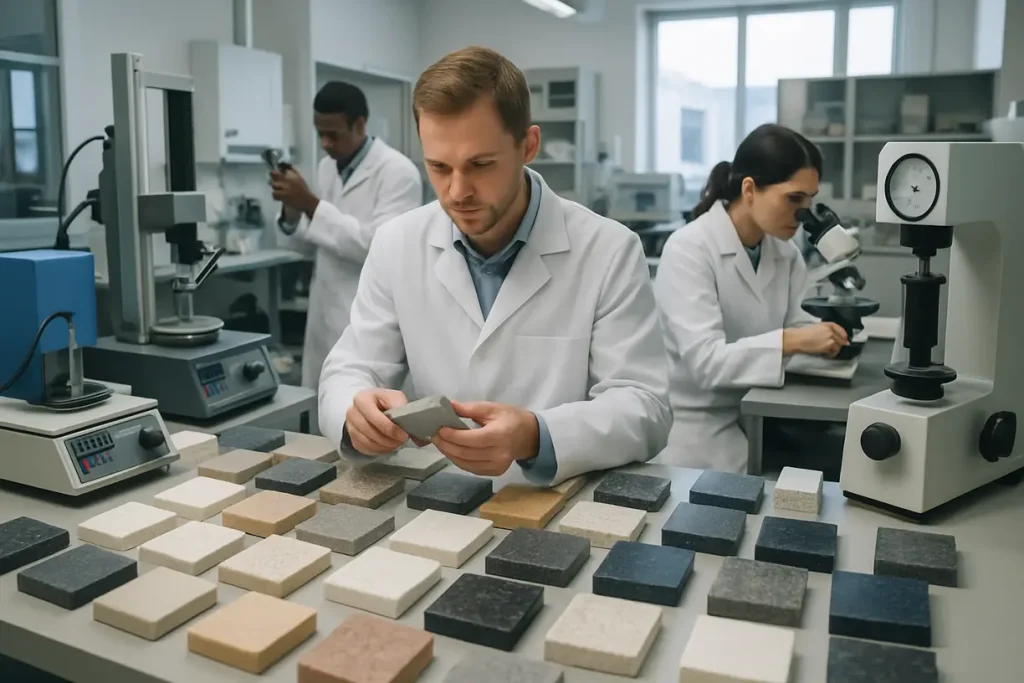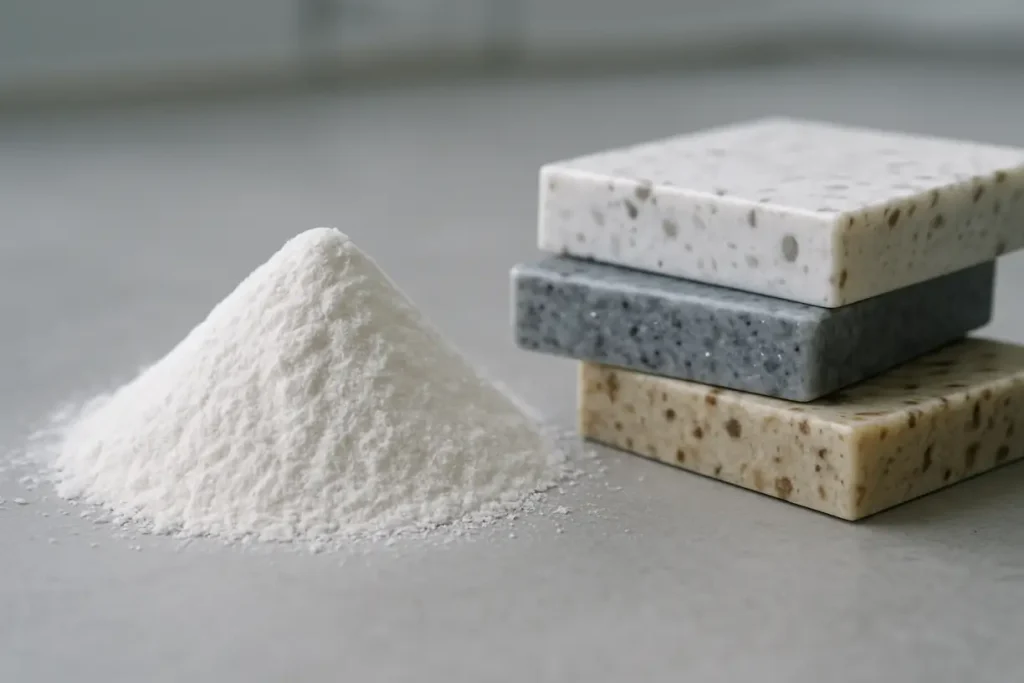In the realm of engineered stone products, understanding the materials used can be crucial for decision-makers. What advantages does zirconium silicate offer for engineered stone? This question addresses a common concern among purchasing managers and industry leaders. The effectiveness of this compound in enhancing product quality is a subject worth exploring. It effectively improves durability, heat resistance, and aesthetic appeal, which are all key factors in maintaining product standards. By examining the benefits of zirconium silicate, industry professionals can make more informed decisions that lead to better outcomes for their projects.

An illustration showing zirconium silicate powder used in the production of engineered stone.
What Is Zirconium Silicate and Its Role in Engineered Stone?
Zirconium silicate is a powerful compound that has become increasingly invaluable in the realm of engineered stone production. Chemical in composition, it is typically seen in powder form and is derived from zirconium, an element known for its remarkable properties. This material brings forth unique attributes that enhance both the functional and aesthetic aspects of engineered stone, making it a crucial component in various applications.
As engineered stone continues to grow in popularity, manufacturers are realizing the benefits of incorporating this compound into their products. This compound is particularly favored for its ability to improve the overall performance and aesthetic appeal of engineered stone surfaces. The inclusion of zirconium silicate directly contributes to several key characteristics that are essential for high-quality materials.
Key Benefits of Zirconium Silicate:
- Strength and Durability: Enhances mechanical strength, ensuring resistance to wear and tear.
- Thermal Stability: Offers protection against thermal shock, preventing cracking from sudden temperature changes.
- Consistent Aesthetics: Ensures uniform color and pattern distribution, improving the visual appeal of products.
Engineered stone products typically consist of natural stone aggregates, resins, and pigments, all combined to create surfaces for a variety of uses. The inclusion of zirconium silicate plays a pivotal role in optimizing the performance of these materials. By enhancing durability and aesthetic qualities, it ensures that engineered stones meet the rigorous demands of modern consumers.
In summary, zirconium silicate is an essential ingredient in the production of engineered stone. Its contributions to strength, thermal stability, and aesthetics considerably elevate the quality of end products, offering significant advantages in the marketplace.
What Are the Key Benefits of Zirconium Silicate?
Zirconium silicate offers several key benefits for engineered stone products. These advantages can significantly impact both performance and customer satisfaction.
Durability and Strength
One of the most significant benefits is its impressive strength. This compound adds robustness to engineered stones, making them far less prone to damage from impacts or everyday wear and tear. This enhanced durability translates to longer-lasting products that can withstand rigorous use in various environments.
Heat and Chemical Resistance
Another critical advantage is its outstanding resistance to heat and chemicals. Whether it’s the heat from hot pots or exposure to various cleaning agents, surfaces containing this material maintain their integrity exceptionally well. This property is particularly valuable for kitchen surfaces that regularly encounter high temperatures and harsh substances.
Aesthetic Qualities
Zirconium silicate also plays a vital role in enhancing the aesthetic appeal of engineered stone. Its use in manufacturing leads to smoother finishes, more vibrant colors, and greater light reflection, ensuring that products not only perform well but also look visually appealing to consumers. As a result, customers are more likely to choose engineered stone products that feature this material for their projects.
These benefits underscore zirconium silicate’s importance in engineered stone applications. It is a material that combines functionality with aesthetic appeal, ensuring that products meet the demands of both manufacturers and consumers.
| Zirconium Silicate Benefits | Description |
|---|---|
| Durability and Strength | Enhances robustness and reduces damage |
| Heat Resistance | Withstands high temperatures without cracking |
| Chemical Resistance | Protects against harsh cleaning agents |
| Aesthetic Enhancement | Improves color vibrancy and surface finish |
How Does Zirconium Silicate Affect Product Performance?
The inclusion of zirconium silicate plays a vital role in enhancing the overall performance of engineered stone products. Understanding this impact can help manufacturers optimize their offerings for better market competitiveness.
Impact on Mechanical Properties
This compound improves the mechanical properties of engineered stone, increasing its tensile strength and rigidity. This enhancement ensures that surfaces remain intact and are less likely to chip or fracture, even under stress from daily use. As a result, products containing zirconium silicate can handle significant loads without compromising their integrity.
Role in Thermal Stability
With its exceptional thermal stability, zirconium silicate helps maintain the structural integrity of engineered stone products. Surfaces remain intact despite exposure to high temperatures, making them suitable for environments such as kitchens where heat exposure is common. This thermal reliability significantly extends the usability of the stone products.
Comparison with Other Materials
When compared to other materials, this compound stands out for its durability and resistance. Many alternatives may lack the comprehensive set of properties provided by zirconium silicate. Some of the specific attributes that illustrate this advantage include:
- High resistance to thermal shock
- Exceptional durability against physical impacts
- Enhanced aesthetic qualities through better surface finishes
These characteristics collectively demonstrate why zirconium silicate is increasingly being favored in the production of engineered stone.
In conclusion, this compound’s contribution to product performance is invaluable. It not only improves the physical characteristics of engineered stone but also ensures that these materials can meet the high expectations of modern consumers while providing lasting value.

A quality testing laboratory where engineered stone products are evaluated for performance and consistency.
Where Is Zirconium Silicate Used in Engineered Stone Products?
Zirconium silicate finds application in various types of engineered stone products, each benefiting from its unique properties. Understanding these applications can help industry professionals recognize the versatility of this compound in enhancing product performance.
Countertops
Zirconium silicate is commonly found in kitchen and bathroom countertops. Its durability and heat resistance make it an ideal choice for surfaces exposed to both high temperatures and frequent use, ensuring longevity and ease of maintenance.
Tiles and Cladding
In flooring and wall cladding, this material enhances the wear resistance and aesthetic appeal of tiles. The inclusion of this material ensures that both residential and commercial spaces maintain their beauty and functionality over time, appealing to property owners and designers alike.
Industrial Products
Beyond residential and commercial applications, zirconium silicate is also used in industrial settings. Its chemical resistance makes it suitable for environments that encounter harsh substances, such as laboratories and manufacturing facilities where durability is crucial.
Additional Areas of Application
- Decorative Surfaces: Utilized in decorative elements in architecture and design.
- Mixing with Other Materials: Often combined with resins and polymers to create composite materials for specialized uses.
These areas of application highlight the versatility of zirconium silicate in engineered stone products. Its presence ensures that various end products can meet performance and aesthetic standards necessary for customer satisfaction.
| Applications of Zirconium Silicate | Example Products |
|---|---|
| Countertops | Kitchen tops, Vanity tops |
| Tiles | Floor tiles, Wall tiles |
| Industrial Products | Chemical containers, Equipment |
What Are the Cost Considerations for Using Zirconium Silicate?
When it comes to incorporating zirconium silicate into engineered stone products, cost considerations play a crucial role. Understanding how this material fits within budgetary constraints is key for manufacturers looking to balance quality with financial feasibility.
Initial Cost vs. Long-term Savings
While the initial investment in zirconium silicate may be higher than some alternative materials, its benefits often translate to long-term savings. The durability of products containing this compound means that they tend to require fewer replacements and less maintenance over time. This durability can lead to a more manageable life-cycle cost, making it a wise investment for manufacturers.
Cost Implications for Manufacturers
Manufacturers must evaluate how the inclusion of zirconium silicate impacts overall production costs. While it may raise the upfront cost of materials, the resulting high-quality products can command better prices in the market. This potential for higher returns can justify the initial expense, particularly in premium products where quality is paramount.
Market Trends and Pricing Factors
The pricing of zirconium silicate can vary based on market trends, demand, and supply chain dynamics. Keeping an eye on these factors can aid manufacturers in making informed sourcing decisions. Regularly assessing the market can also uncover opportunities for bulk buying or long-term contracts, which can help mitigate costs.
In summary, while zirconium silicate may represent a higher initial cost, its long-term benefits frequently outweigh this investment. To maximize the benefits, manufacturers should consider the following:
- Assess the durability requirements for specific applications.
- Explore potential bulk purchasing options to lower costs.
- Monitor market trends related to pricing.
These considerations will help manufacturers ensure that their investment aligns with their business objectives and enhances product offerings.
| Cost Considerations | Details |
|---|---|
| Initial Cost | Higher than some alternatives |
| Long-term Savings | Reduced need for replacements |
| Market Trends | Fluctuating prices based on demand |
How Does Zirconium Silicate Contribute to Sustainability?
In today’s market, sustainability has become an essential consideration for many businesses. Zirconium silicate contributes positively to this aspect in several ways, making it a valuable asset in the manufacturing of engineered stone products.
Eco-friendly Aspects
Zirconium silicate is derived from natural resources, making it a more eco-friendly option compared to synthetic materials. By incorporating materials like zirconium silicate, manufacturers can appeal to environmentally conscious consumers and minimize their ecological footprint. Furthermore, its natural origins often require less energy-intensive processing compared to some alternative materials.
Reduction of Waste in Production
Using zirconium silicate can help minimize waste during the production process. Its properties allow manufacturers to create stronger products with less material, thereby reducing the overall waste generated in fabrication. Every improvement in material efficiency leads to a more sustainable production cycle and can also enhance profitability.
Lifecycle Assessment of Products
From production to disposal, products made with zirconium silicate tend to have a lower environmental impact. Their durability extends their lifecycle significantly, contributing to less frequent replacements and a reduced volume of waste entering landfills. This longevity not only benefits the environment but also offers cost savings for consumers in the long run.
Additionally, the following strategies can enhance sustainability in the use of zirconium silicate:
- Recycling and Reusability: Explore options for recycling engineered stone products at the end of their lifecycle, promoting a circular economy.
- Sustainable Sourcing: Work with suppliers who prioritize sustainable mining and processing practices for zirconium silicate.
Incorporating this material can help companies align with sustainability goals. By choosing greener options, businesses not only enhance their brand image but also contribute positively to environmental efforts.
| Sustainability Contributions | Description |
|---|---|
| Eco-friendly Aspects | Derived from natural resources |
| Waste Reduction | Stronger products result in less waste |
| Longer Lifecycle | Reduces frequency of product replacements |
Are There Any Limitations to Using Zirconium Silicate?
While zirconium silicate has many advantages, it is important to consider some limitations as well. This understanding can help manufacturers make balanced decisions.
Potential Drawbacks in Certain Applications
In specific applications, zirconium silicate may not be the best choice. For example, under extreme conditions or in specialized environments, its properties may not provide the desired performance.
Comparison with Alternative Materials
While this material offers many benefits, other materials may be better suited in niche applications. For instance, some polymers may provide better flexibility, depending on the intended use.
Strategies for Overcoming Limitations
To mitigate potential downsides, manufacturers can combine zirconium silicate with other materials to enhance performance characteristics. This composite approach often leads to superior results.
In summary, while zirconium silicate has non-negligible limitations, strategic positioning and combination with other materials can lead to optimized performance in engineered stone products.
| Limitations | Description |
|---|---|
| Potential Drawbacks | May not perform well in extreme conditions |
| Comparison with Alternatives | Other materials may be more suitable in specific situations |
| Solutions | Combination with other materials for enhanced performance |
What Innovations Are Emerging in Zirconium Silicate Applications?
The world of materials science is always advancing, and zirconium silicate is no exception. New innovations are constantly reshaping how this compound is used in engineered stone products.
Recent Advancements in Technology
Technological advancements have led to improved methods of incorporating zirconium silicate into stone products. Innovations in processing technology enhance the bonding of zirconium compound with other materials, resulting in better overall performance.
New Product Developments
Manufacturers are continually developing new engineered stone products that leverage the benefits of zirconium silicate. These products often showcase enhanced aesthetics and better functional properties, making them appealing in competitive marketplaces.
Future Trends Impacting the Market
As sustainability and durability become more important, the demand for materials like zirconium silicate is likely to rise. Future innovations may focus on further improving its properties or developing even more sustainable sourcing methods.
In conclusion, staying updated on innovations in zirconium silicate applications can pose significant advantages. By embracing these changes, manufacturers can enhance their product offerings and improve competitiveness in the market.
| Emerging Innovations | Examples |
|---|---|
| Technological Advancements | Improved processing methods |
| New Product Developments | Advanced engineered stone products |
| Future Trends | Increased demand for sustainable options |
How Can Manufacturers Optimize the Use of Zirconium Silicate?
For manufacturers looking to get the most out of zirconium silicate, optimizing its use is key. Here are several best practices to consider.
Best Practices in Material Selection
Choosing the right grade of zirconium silicate is essential. Not all grades offer the same properties, so understanding the specific needs of your products will guide optimal selection.
Techniques for Enhancing Performance
Incorporation techniques can significantly impact the effectiveness of zirconium silicate. Using high-energy mixing methods can improve dispersion and bonding, boosting overall performance.
Testing and Quality Assurance Methods
Routine testing should assess the performance characteristics of engineered stone containing zirconium silicate. Quality assurance processes will ensure that products meet industry standards and customer expectations.
Ultimately, optimizing zirconium silicate use can significantly improve engineered stone products. Manufacturers can realize better value and satisfaction through targeted practices.
| Optimization Strategies | Key Actions |
|---|---|
| Material Selection | Choose the right grade |
| Performance Enhancement Techniques | High-energy mixing |
| Quality Assurance | Routine testing and assessments |
What Should B2B Buyers Know Before Purchasing Zirconium Silicate Products?
B2B buyers must consider various factors when sourcing zirconium silicate products. Here are essential points to keep in mind.
Key Questions to Ask Suppliers
Buyers should inquire about the sources of zirconium silicate, production methods, and compliance with industry standards. Understanding these factors can help gauge the quality and reliability of the products.
Factors for Evaluating Quality and Performance
When evaluating products, consider performance metrics such as durability, heat resistance, and aesthetics. Having specific criteria ensures that the chosen zirconium silicate products align with project requirements.
Importance of Vendor Reliability
Selecting a trustworthy supplier is paramount. Research the vendor’s reputation and customer reviews to ensure reliable and high-quality product delivery.
In summary, informed decision-making can significantly enhance the purchasing process. By focusing on quality and supplier reliability, B2B buyers can secure the best zirconium silicate products for their needs.
| Considerations for B2B Buyers | Details |
|---|---|
| Supplier Questions | Inquire about sourcing and standards |
| Quality Evaluation | Assess performance metrics |
| Vendor Reliability | Research supplier reputation |
Conclusion
In this exploration, we have highlighted the various advantages that zirconium silicate offers for engineered stone products. This material enhances durability, improves heat resistance, and elevates aesthetic appeal, making it essential for competitive offerings. By leveraging zirconium silicate, businesses benefit from reduced replacement costs and increased customer satisfaction. To further explore how Global Industry can assist you in sourcing top-quality zirconium silicate products, we encourage you to reach out today. Together, we can elevate your product offerings and strengthen your competitive edge in the market.

An overview of zirconium silicate powder being used in the manufacturing process of engineered stone products, showcasing its importance in enhancing durability and aesthetics.
FAQ Section
Q1: What industries benefit from zirconium silicate?
Zirconium silicate is primarily utilized in the construction and manufacturing sectors. It enhances engineered stone products, making them suitable for countertops, tiles, and cladding in residential and commercial buildings. Additionally, industries like ceramics and glass manufacturing also benefit from the improved properties zirconium silicate offers.
Q2: Why is zirconium silicate preferred over other materials?
Zirconium silicate is favored due to its remarkable qualities, including exceptional strength, high heat resistance, and aesthetic versatility. Unlike some alternatives, it maintains its structural integrity under various conditions and contributes to a more attractive finish, which is essential for high-quality engineered stone products.
Q3: How does zirconium silicate improve engineered stone appearance?
This material enhances the visual appeal of engineered stone by increasing color vibrancy, clarity, and uniformity. It allows for smoother finishes and better light reflection, giving the surfaces a polished look that attracts consumers and meets aesthetic demands in modern architecture.
Q4: Is zirconium silicate environmentally friendly?
Yes, zirconium silicate is considered to be environmentally friendly. It is sourced from natural minerals, thus reducing the ecological footprint associated with synthetic alternatives. Its durability also means that products made with it are long-lasting, which contributes to lower overall resource consumption and waste.
Q5: What should I consider when sourcing zirconium silicate?
When sourcing zirconium silicate, it’s crucial to assess the supplier’s reputation for quality and reliability. Verify that their products meet industry standards and compliance regulations. Additionally, consider the consistency of their product quality and whether they provide technical support or information regarding best practices for use in your specific applications.
